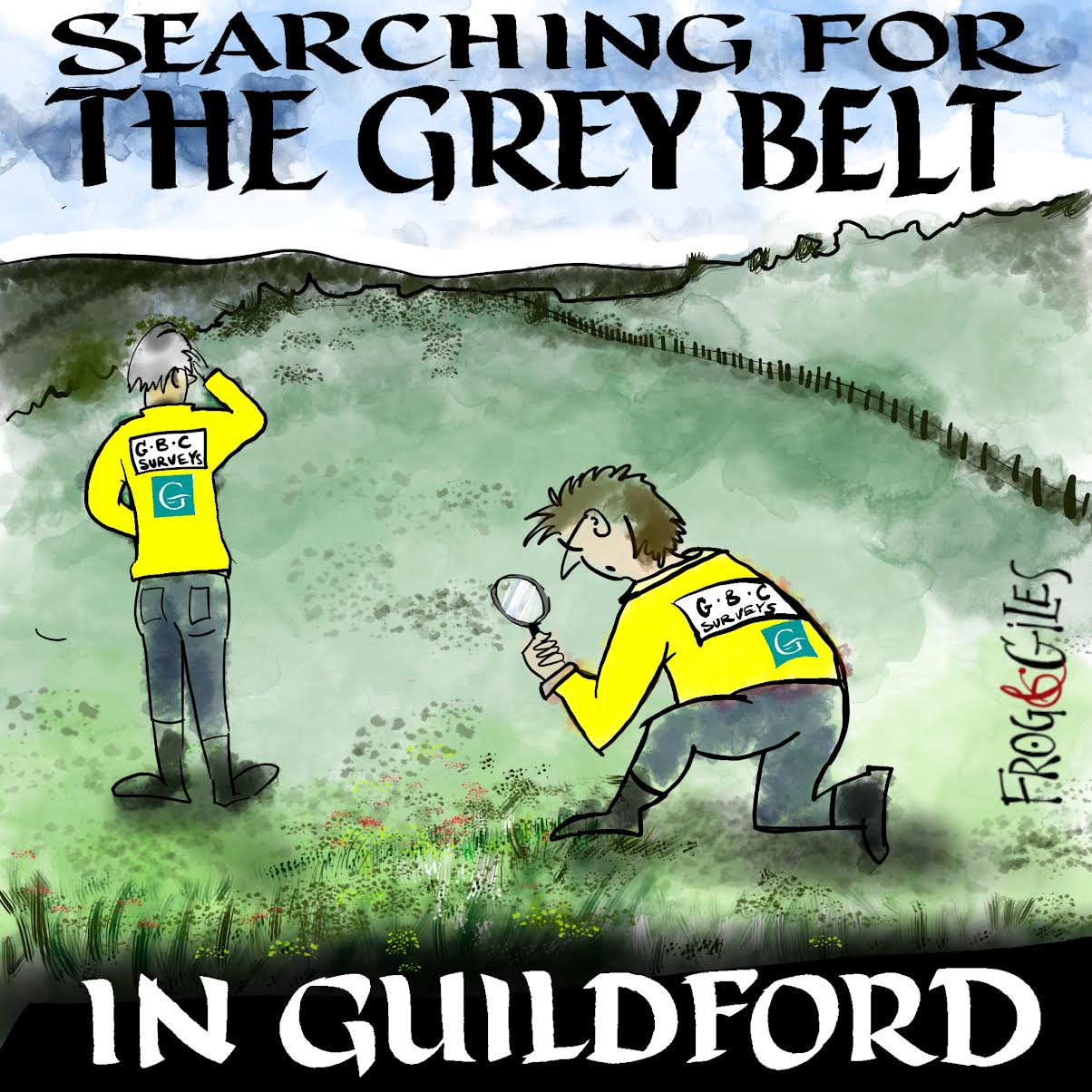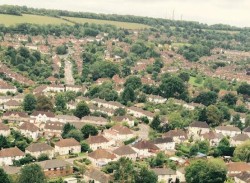 Abraham Lincoln
If given the truth, the people can be depended upon to meet any national crisis...
Abraham Lincoln
If given the truth, the people can be depended upon to meet any national crisis...
 Guildford news...
for Guildford people, brought to you by Guildford reporters - Guildford's own news service
Guildford news...
for Guildford people, brought to you by Guildford reporters - Guildford's own news service
Letter: No One Is Arguing That The Green Belt Is ‘Sacrosanct’
Published on: 22 Apr, 2016
Updated on: 22 Apr, 2016
As a matter of fact, no one is arguing that the green belt is “sacrosanct” as Gordon Bridger suggests in his letter: Guildford Needs More Houses – Green Belt Should Not Be Sacrosanct. Its so-called sanctity is a fiction or an Aunt Sally set up by the development lobby to justify their building plans.
Mr Bridger might take these facts into consideration:
1. If, as Mr Bridger alleges, companies are no longer coming to Guildford, it is likely to be because, as Cllr Furniss [Con, Christchurch] stated in the council chamber, they are concerned at the inadequacies of the transport system – especially the A3 – and the resultant excessive journey times. Anyone who uses the A3 daily knows this.
 2. Instead of repeating the simple slogans about their being a housing shortage, Mr Bridger might examine the statistics. The ONS [Office of National Statistics] figures actually show that the population of the borough is expected to fall by 2031 if international immigration is excluded.
2. Instead of repeating the simple slogans about their being a housing shortage, Mr Bridger might examine the statistics. The ONS [Office of National Statistics] figures actually show that the population of the borough is expected to fall by 2031 if international immigration is excluded.
3. House prices are undoubtedly very high. With inward investment into residential property and further monetary easing resulting in further lending against property this may even get worse. Annual supply of houses has not been much above one per cent of housing stock and even if it doubled or trebled it is not credible this would have any material effect on house prices.
4. It is not the case that land accounts for two thirds of housing costs. Take the case of the agricultural land at Three Farms Meadow which a Cayman’s company acquired for £7 million. It proposed to put 2,068 dwellings on this farmland. Cost per dwelling £3,384. That’s hardly a lot and it’s a tiny fraction of the expected average selling price of over £300,000.
5. What we are desperately short of is council housing. Why does Mr Bridger never mention this? Does he approve of the fact that every year the council sells off this social asset at an under-value? Does his concern reach the level of practicality or is he just a theoretician who does not look at facts?
Responses to Letter: No One Is Arguing That The Green Belt Is ‘Sacrosanct’
Leave a Comment Cancel replyPlease see our comments policy. All comments are moderated and may take time to appear. Full names, or at least initial and surname, must be given.

"Found any?" - "Nope, it all looks green to me!" (See Opinion: The Future is Congested, the Future is Grey)




Recent Articles
- Postcode Lottery Police Funding – It ‘Cannot Be Fair’ Says Police Commissioner
- Heartbreak for City Again as Two Extra-time Goals Snatch Victory
- Letter: All Three Major National Parties Are Relaxed About Green Belt Giveaways
- Updated: Ash Level Crossing Decision ‘Was Made Without Approval of Surrey Highways’
- Sara Sharif Trial Latest – ‘Fear and Violence Reigned’ in Sara’s Home
- Dragon Interview: Julia McShane leader of GBC’s Lib Dems
- Letter: Ash Bridge – We Need Accountability and Competence
- Letter: SCC’s Final Decision is Unlikely to Put an End to the Issue of the London Road Layout
- Only Cabinet Members Will Speak at SCC’s Meeting to Decide on London Road Scheme
- Highways Bulletin for November 25


Recent Comments
- Jane Hughes on Sara Sharif Trial Latest – ‘Fear and Violence Reigned’ in Sara’s Home
- John Ferns on Ash Level Crossing Will Close Before Opening of New Road Bridge
- Olly Azad on Ash Level Crossing Will Close Before Opening of New Road Bridge
- Roshan Bailey on Student Named Land Based and Horticulture Learner of the Year
- Frank Emery on Ash Level Crossing Will Close Before Opening of New Road Bridge
- Paul Robinson on Letter: The Active Travel Proposal Is the Safest Option for London Road
Search in Site
Media Gallery
Dragon Interview: Local Artist Leaves Her Mark At One of England’s Most Historic Buildings
January 21, 2023 / No Comment / Read MoreDragon Interview: Lib Dem Planning Chair: ‘Current Policy Doesn’t Work for Local People’
January 19, 2023 / No Comment / Read MoreA3 Tunnel in Guildford ‘Necessary’ for New Homes, Says Guildford’s MP
January 10, 2023 / No Comment / Read More‘Madness’ for London Road Scheme to Go Ahead Against ‘Huge Opposition’, Says SCC Leader
January 6, 2023 / No Comment / Read MoreCouncillor’s Son Starts Campaign for More Consultation on North Street Plan
December 30, 2022 / No Comment / Read MoreCounty Council Climbs Down Over London Road Works – Further ‘Engagement’ Period Announced
December 14, 2022 / No Comment / Read MoreDragon Interview: GBC Reaction to the Government’s Expected Decision to Relax Housing Targets
December 7, 2022 / No Comment / Read MoreHow Can Our Town Centre Businesses Recover? Watch the Shop Front Debate
May 18, 2020 / No Comment / Read More







George Potter
April 22, 2016 at 4:40 pm
Really? “No one” is arguing that the green belt should be sacrosanct?
Then please, pray tell, what is the purpose of the Guildford Greenbelt Group? I’m pretty sure the likes of Cllr Susan Parker have been quite strident in expressing their opposition to any and all development on the green belt.
Ben Paton
April 22, 2016 at 11:32 pm
If Mr Potter can cite any statement made by Guildford Greenbelt Group (GGG) that the Green Belt is ‘sacrosanct’ then he might have a point. Let him prove his point, if he can.
Until such time, members of the public may find GGG’s website a more reliable guide to that party’s policies than Mr Potter.
The purpose of GGG is to protect the quality of the built and natural environment in the borough. My understanding is that its stated view is that brownfield should be developed before greenfield.
It takes a talent for getting the wrong end of the stick to confuse that simple proposition with the completely different idea that the green belt is ‘sacrosanct’.
The fact is 84 per cent of the area proposed for development in the revised Local Plan is in the green belt. The only reason the proportion is not 100 per cent is that 16 per cent is planned for Ash and Tongham, currently not in the green belt. It is not possible to make the case that the green belt is getting off lightly. It is taking almost all of the new development.
The only green belt that may be sacrosanct seems to be the Conservative party’s proposal to create a new, special green belt in Ash and Tongham, represented by the leader of the council. That green belt is, it seems, very special because it does not appear to serve Metropolitan London, only Ash and Tongham.
David Roberts
April 23, 2016 at 7:26 pm
I have never heard any member of the GGG, including Cllr Parker, say ther must be no development at all in the green belt. Quite the reverse.
Personally I would be happy to see every community in the borough take on a fair burden of meeting an objectively assessed housing need in proportion to their population size. But the revised Local Plan:
1. assesses housing need using a secret formula whose objectivity therefore cannot be judged;
2. fails to apply green belt or infrastructure constraints to its arithmetic, as government policy requires; and
3. proposes to dump a disproportionate housing load into the countryside – expelling many villages from the green belt to make this easier.
Transparency and fair burden-sharing is the way out of this mess.
Gordon Bridger
April 25, 2016 at 7:20 pm
I note with interest that Mr Paton is not arguing that the boundary of the green belt is sacrosanct and agree with him that traffic is the major technical problem. I also agree with him that council housing should be a priority and hope to produce a policy statement on economics of housing soon.
I disagree however that land prices are not the major factor in house costs and that if one can release some very small areas of land currently in the green belt we should be able to fund badly needed house for a younger skilled generation.
Which is the higher priority homes or views?
Ben Paton
April 26, 2016 at 12:13 pm
To answer Mr Bridger’s question, the highest priority is to have a properly disclosed demographic projection of the local ‘need’ for housing.
Mr Bridger appears to be among those who prefer to take on trust a sub-sub-contractor’s demographic model – a model that the council says it has never received.
Having a transparent process which is genuinely ‘objective’ and results in a ‘sustainable’ local plan is a higher priority than either homes or views. Why not answer the logically prior question, what is the housing need?
Avoiding this fundamental question proves that the ‘golden thread’ in this local plan is politics – not sustainability. Why just jump to a conclusion without transparent disclosure of the demographic facts?
Will Mr Bridger set out the basis of his housing need projections? Why should we take them on trust? Is his crystal ball better than anyone else’s?
Roland McKinney
April 26, 2016 at 11:47 pm
Gordon Bridger is wrong in his assertion that land costs are a major factor in house prices. I’d refer him to the accounts of any of the major house building firms.
If he cared to look at Berkeley Group, for example, in their accounts for the year ending in 2015, he would find that the land cost per plot is given as £58,000 – on dwellings with an average price of £575,000. So the plot cost was just over 10 per cent of the price.
I’d point out that a major part of Berkeley Homes developments are in London, and so plot costs outside London are likely to be lower.
Oh – and the profit before tax on each dwelling? It works out at £134,500, close to 25 per cent of the price. Bear in mind that this profit is after providing a package worth more than £22 million to the company chairman for his year’s work, making him the second highest paid person in Britain in 2015.
And one wonders why house prices are high.
Ben Paton
April 27, 2016 at 8:55 am
And how much of these tens of millions of remuneration and profits get re-cycled into lobbying politicians and the Conservative party and paying consultants like Savills to promote removing environmental constraints like the green belt so that they can make still more money?